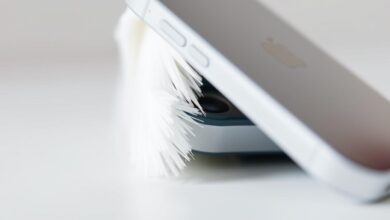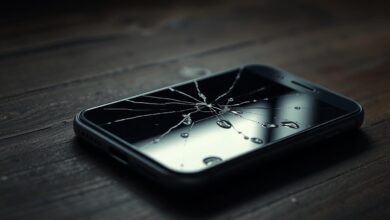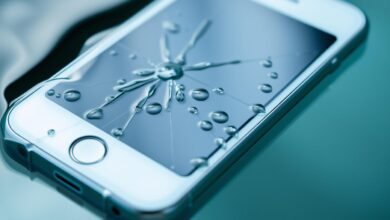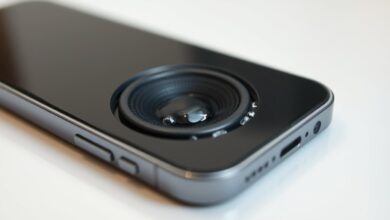how to remove water from iphone
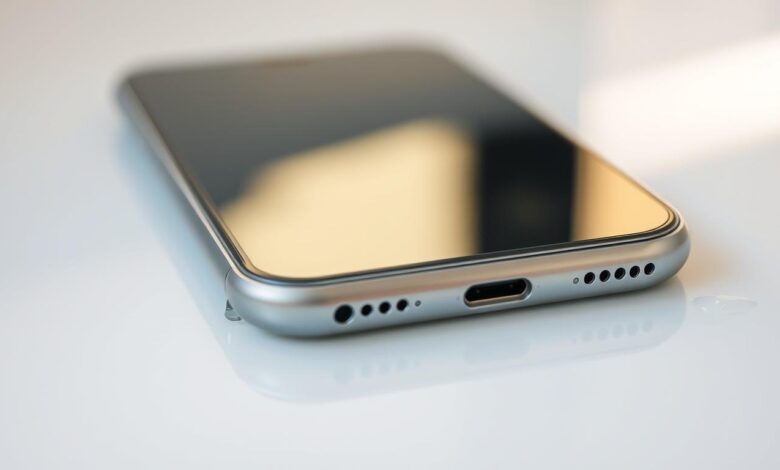
Dropping your iPhone in water can be really stressful. It doesn’t matter if it’s a sink, bathtub, or a puddle. Water damage can harm your device a lot. But, there are steps you can take to dry out your iPhone and maybe save it.
One good way is to use an app like Water Eject. It uses sound frequencies to push water out of the speakers. This app has both manual and automatic modes, so it’s easy for many people to use.
By following the right steps, you can increase your chances of fixing your wet iPhone. In this guide, I’ll show you how to remove water from your iPhone. I’ll also give you tips to avoid damage in the future.
Key Takeaways
- Use an app like Water Eject to help remove water from iPhone speakers.
- The app offers manual and automatic modes for different user preferences.
- Act quickly to dry out your iPhone and prevent further damage.
- Check your iPhone’s speakers after water ejection to ensure they’re working properly.
- Consider using additional features like bass testing to verify your iPhone’s sound quality.
Understanding Water Damage in iPhones
Knowing how water damage impacts iPhones is key to preventing or fixing it. Water and electronics don’t mix, and iPhones are no different.
How Water Affects iPhone Components
Water in an iPhone can harm the internal parts. The water can corrode the circuitry, causing short circuits. This makes the device unusable. Water can also damage the display, battery, and other important parts, leading to expensive fixes or replacements.
The Myth of Rice as a Drying Agent
Many think rice can dry out a wet iPhone. But, this method is mostly useless and can harm more. Rice leaves dust and starch, damaging the device’s inner parts.
Water Damage vs. Liquid Damage
It’s important to know the difference between water and liquid damage. Water damage is from plain water, while liquid damage includes saltwater, sugary drinks, and more. Liquid damage can be harder to fix because these substances are corrosive.
In summary, understanding water damage in iPhones is crucial. By knowing how water affects components and debunking myths, you can protect your device better.
Identifying Signs of Water Damage
If your iPhone has been in contact with water, knowing what to look for can save you from further damage. Water exposure can show up in many ways. It’s important to recognize these signs quickly.
Visual Indicators of Water Exposure
Look for corrosion on the inside or water spots on the screen. You might see discoloration or mineral deposits around the SIM card tray or other openings. Check your iPhone for any signs of moisture.
Functional Issues Caused by Moisture
Moisture can lead to problems like a malfunctioning touchscreen or distorted sound from the speakers. If your iPhone acts strangely after being wet, moisture is likely the cause.
Checking the Liquid Contact Indicator
The Liquid Contact Indicator (LCI) changes color when it meets water. To check the LCI, look in the SIM card tray or on the logic board. A color change, usually to red or pink, means your iPhone has been wet. Here’s where to find the LCI on different iPhone models:
| iPhone Model | LCI Location |
|---|---|
| iPhone 12 and later | SIM card tray |
| iPhone 11 and earlier | Logic board or SIM card tray |
| iPhone 8 and earlier | Inside the SIM card slot |
By checking these indicators, you can figure out if your iPhone has water damage. Then, you can take steps to fix the problem.
Immediate Actions to Take When Your iPhone Gets Wet
When your iPhone gets wet, every second matters. Quick action can greatly reduce damage risk. It stops water from getting into the inside parts.
Power Off Your Device Immediately
The first thing to do is to power off your iPhone right away. This stops short circuits that could harm it more. If it’s already off, don’t turn it on until it’s dry.
Remove Case and Accessories
Then, take off any cases or accessories from your iPhone. This makes drying it easier and stops water from causing more harm.
Wipe External Moisture
Use a soft cloth to gently wipe off any moisture outside. Don’t press too hard, as this could push water inside.
Remove SIM Card
Take out the SIM card to let it dry and avoid damage. This also lets you dry the SIM card slot.
By taking these quick steps, you can greatly increase your iPhone’s chances of recovering from water damage. You’ll learn how to effectively remove water from your iPhone.
How to Remove Water from iPhone
Removing water from your iPhone is urgent and needs the right steps. When your device meets water, acting fast is key to reduce harm.
Using the Water Eject Feature (iOS14+)
For iPhones on iOS 14 or later, Apple has a built-in water eject feature. You can find it in the Shortcuts app. A specific shortcut emits a sound that pushes water out of the iPhone’s speakers and openings.
Using Siri Shortcuts for Water Ejection
Siri Shortcuts can help remove water from your iPhone. Create or download a shortcut that plays a sound frequency. Then, use Siri to start the water ejection. This method is handy because you don’t need to open the Shortcuts app.
Manual Methods for Older iPhone Models
Older iPhone models lack the Water Eject feature. For them, manual methods are needed. One way is to tap the device gently against your hand with the Lightning port down. This can push water out of the port.
Gently Tapping and Positioning Your Device
When manually removing water, place your iPhone to let gravity help. Hold it with the Lightning port down and tap it softly against your hand. This can help water leave the device. As Apple Support advises, wiping your iPhone with a soft cloth can also remove moisture.
By using these methods, you can remove water from your iPhone and possibly save it. The main thing is to act fast and use the correct techniques for your device.
Effective Drying Techniques for iPhones
There are several ways to dry out your iPhone and avoid damage. It’s important to act fast and use the right methods. This will help keep your device safe.
Air Drying Method
The air drying method is easy and effective. Start by gently patting your iPhone with a soft cloth to remove moisture. Then, put it in a dry, well-ventilated area away from sunlight or heat.
This method uses air to dry your iPhone. It’s a simple way to get rid of moisture.
Using Silica Gel Packets
Silica gel packets are great at soaking up moisture. To dry your iPhone, put it in a container with silica gel packets. Make sure your iPhone is fully covered by the packets.
The silica gel will soak up moisture from your iPhone. This method is good for drying the inside of your device.
Low Heat Methods
Low heat can help dry out your iPhone. You can use a hair dryer on a low setting, but keep it far away. Be careful not to use too much heat, as it can damage your iPhone.
Another option is to place your iPhone near a warm radiator or heater. Just make sure it’s not too hot.
Drying Time Requirements
The time it takes to dry your iPhone depends on the method and how wet it is. It’s best to let it dry for 24 to 48 hours before turning it on. If you use silica gel packets or air drying, wait 48 hours.
Using these drying techniques can help save your iPhone from water damage. Be patient and let it dry completely before using it again.
What NOT to Do with a Water-Damaged iPhone
If your iPhone got wet, there are things you shouldn’t do. Handling it carefully can help save it. It’s important to avoid actions that could make damage worse.
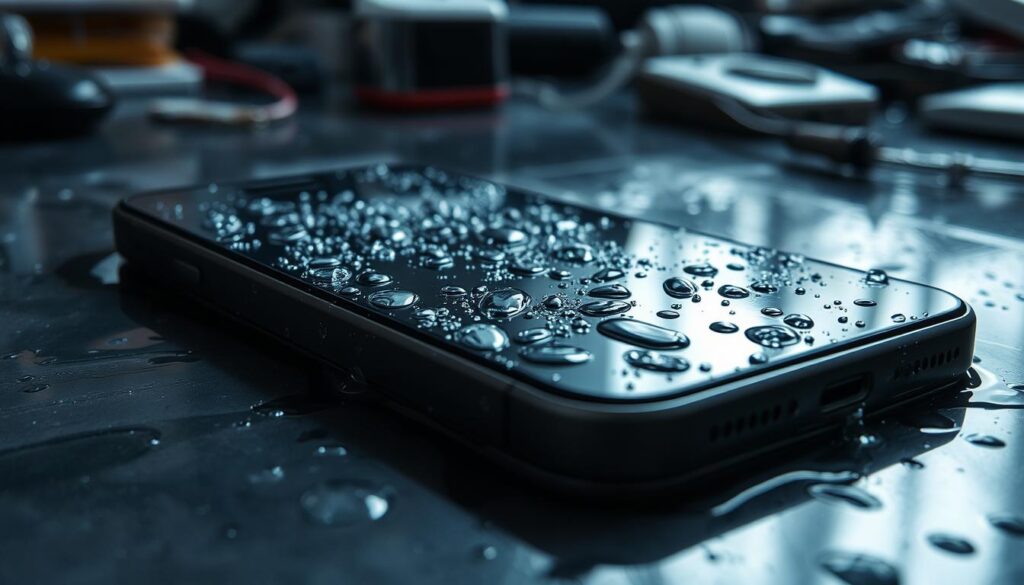
Avoid Heat Sources
Don’t use a hair dryer or oven to dry your iPhone. High heat can damage the inside and cause short circuits. Let it dry naturally instead.
Don’t Charge Until Completely Dry
Charging a wet iPhone can cause permanent damage. Wait until it’s dry before charging. This patience can save your device from costly repairs.
Avoid Shaking or Tilting
Don’t shake or tilt your iPhone to remove water. This can push water into the device and harm it more. It’s better to let it dry naturally.
Skip the Rice Method
The rice method is not as good as people think. Rice can leave dust and debris that cause more problems. Use silica gel packets or air drying instead.
By avoiding these mistakes, you can help your iPhone recover from water damage. If your iPhone is damaged, be careful and patient.
Using Sound Waves to Expel Water
A lesser-known method for dealing with a wet iPhone involves using sound waves to push out water. This method has caught attention for its ability to remove water from inside the device.
Third-Party Apps for Water Removal
Many third-party apps claim to help get rid of water from your iPhone with sound. These apps make specific sounds to help water come out of the device’s speakers and openings.
Using Sound Frequencies to Dislodge Water
The idea behind sound waves is that certain sounds can create vibrations. These vibrations help push water out of the iPhone’s parts. Some apps mix low and high-frequency sounds to do this.
Limitations of Sound-Based Methods
Sound wave technology can be useful, but it has its limits. How well it works depends on how much water got in and the iPhone model. It’s best to use this method along with other drying techniques, not instead of them.
| Method | Effectiveness | Recommendation |
|---|---|---|
| Sound Waves | Variable | Use with other drying methods |
| Air Drying | High | Primary method |
| Silica Gel | High | Effective for internal drying |
Dealing with Different Types of Liquid Damage
iPhone liquid damage varies by the type of liquid. The liquid’s nature greatly affects the damage. When your iPhone meets a liquid, the damage can vary.
Freshwater vs. Saltwater Exposure
Freshwater and saltwater affect your iPhone differently. Freshwater is less corrosive. Saltwater, with its high salt content, can cause faster corrosion.
If your iPhone meets saltwater, clean it quickly. This helps reduce damage.
Handling Damage from Sugary or Alcoholic Drinks
Sugary drinks and alcohol can harm your iPhone. Their viscosity and sugar can clog internal parts. Alcohol, though less thick, can still damage due to its corrosive nature.
Act fast to lessen the damage.
Chemical Liquid Exposure
Chemicals, like cleaning products, can severely harm your iPhone. They can corrode metal and damage circuits. If chemicals touch your iPhone, turn it off right away and get professional help.
Special Cleaning Considerations
When cleaning liquid damage, avoid harsh chemicals and abrasive materials. They can harm your iPhone more. Gently dry the outside with a soft cloth.
Consider using desiccants or professional drying services for thorough drying.
Knowing the liquid type is key to fixing your iPhone. Whether it’s freshwater, saltwater, or another liquid, the right response can save your device.
iPhone Water Resistance Explained
iPhone water resistance is a great feature, but many people don’t fully understand it. It’s important to know what it can and can’t do. Let’s explore the technology behind it.
IP Ratings and What They Mean
The IP rating shows how well a device can handle solid particles and water. iPhones have different IP ratings. For example, the iPhone 14 Pro can handle water up to 4 meters deep for 30 minutes. Knowing your iPhone’s IP rating is key to understanding its water resistance.
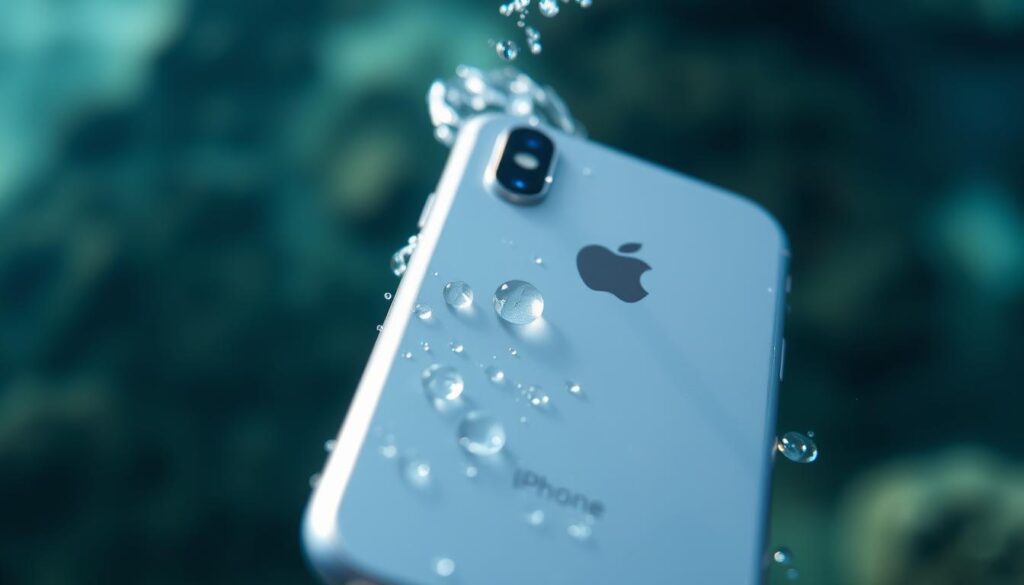
Water Resistance Limitations by iPhone Model
Each iPhone model has its own water resistance level. The iPhone 7, for instance, has a lower rating than the iPhone 12 series. Always check your iPhone’s specs to know its limits.
How Water Resistance Degrades Over Time
Water resistance can decrease over time. This happens due to wear and tear, chemicals, or physical damage. As the seals around the iPhone’s openings wear out, it becomes more vulnerable to water.
Common Misconceptions About Water Resistance
Many think water-resistant iPhones are completely waterproof. But, water resistance and waterproofing are different. iPhones can handle accidental water exposure but aren’t meant for long underwater use or high-pressure water.
Professional Repair Options for Water Damage
If your iPhone gets wet, getting it fixed by a pro is usually the best move. Water damage can cause big problems if not fixed right. Experts have the right tools and know-how to find and fix issues.
Apple Store vs. Third-Party Repair Services
You can choose between Apple Store and third-party repair services. The Apple Support page helps find authorized services. Apple Stores use real parts and offer warranty-backed fixes. But, third-party services might be cheaper. Just make sure to pick a trusted third-party service for quality work.
Cost Considerations for Water Damage Repair
Repair costs can change a lot, depending on the damage and iPhone model. Always ask for a price quote before fixing your phone.
What to Expect During Professional Repair
Experts will check the damage, swap out broken parts, and test your iPhone. They make sure it works right.
Timeline for Professional Repairs
How long it takes to fix your iPhone can vary. It might be a few hours or a few days. This depends on the problem’s complexity and the service’s schedule.
Checking the iPhone Water Indicator
The Liquid Contact Indicator (LCI) is key in figuring out if your iPhone has been wet. It changes color when it meets liquid, showing if water damage might be a problem.
Locating the LCI on Different iPhone Models
The LCI spot changes with each iPhone model. For most, it’s in the SIM card tray or on the logic board. To see it, take out the SIM card tray with a paper clip or SIM ejector tool. Look for a small white or silver indicator. If it’s red or pink, your iPhone has been wet.
Interpreting LCI Results
If the LCI has turned color, it doesn’t mean your iPhone is ruined. But, it shows your device has been wet. The damage’s extent depends on the liquid type and how long it was exposed.
What a Triggered LCI Means for Warranty
A triggered LCI can affect your warranty. Apple might void it if the LCI shows liquid damage. Yet, a triggered LCI doesn’t mean you’re out of luck. You should talk to Apple support to see what they can do.
False Positive Indicators
Sometimes, the LCI can go off due to humidity or other things, not just water. This can be a worry if you’re checking if your iPhone is still under warranty. If you think it’s a false alarm, get help from an Apple-approved service provider.
Data Recovery from Water-Damaged iPhones
If your iPhone got wet, getting your data back is urgent. Water can cause a lot of data loss. But, there are ways to get your important info back.
Backup Options After Water Exposure
First, check if you have a backup. If you back up to iCloud or iTunes, you can restore your data. Do this fast to prevent more damage.
Professional Data Recovery Services
If you don’t have a backup, professional help is an option. File Savers Data Recovery can help with water-damaged devices. They’re great if your data is crucial and you don’t have a backup.
Preventative Measures for Data Protection
To avoid data loss, take steps to protect your data. Regular backups are essential. Set up automatic backups to cloud storage like iCloud or Google Drive.
Cloud Storage Solutions
Cloud storage adds extra protection for your data. It lets you access your files from any device, even if your iPhone is damaged. iCloud, Google Drive, and Dropbox are popular choices.
| Cloud Storage Service | Free Storage | Paid Plans |
|---|---|---|
| iCloud | 5GB | $0.99 – $9.99/month |
| Google Drive | 15GB | $1.99 – $99.99/month |
| Dropbox | 2GB | $9.99 – $16.58/month |
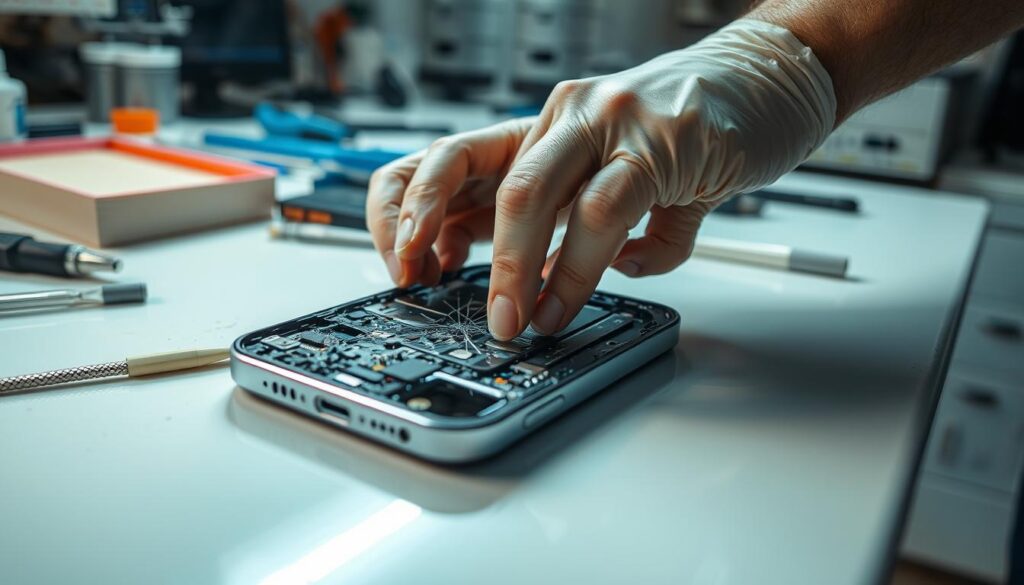
Insurance and Warranty Considerations
When your iPhone gets water damage, knowing your insurance and warranty is key. Accidental damage, like water exposure, can be expensive to fix.
AppleCare+ Coverage for Water Damage
AppleCare+ is an extended warranty from Apple. It covers up to two incidents of accidental damage, including water. With AppleCare+, fixing water damage is much cheaper. But, you must buy AppleCare+ soon after getting your iPhone.
Carrier Insurance Policies
Many carriers offer insurance for accidental damage, including water. These policies differ in what they cover and how much they cost. It’s important to check your carrier’s policy to know what’s included.
Third-Party Insurance Options
There are also third-party insurance options for mobile devices. They cover accidental damage, including water. These might offer more coverage than carrier policies.
Documentation for Claims
When filing a claim, you’ll need the right documents. This includes proof of purchase, the damaged device, and a detailed incident report. Keeping these documents ready can make the claims process easier.
Knowing your insurance and warranty can help a lot if your iPhone gets water damage. It’s wise to check your options before something happens.
Preventing Future Water Damage
To keep your iPhone safe from water damage, take some steps. Water resistance helps, but it’s not perfect. By being proactive, you can lower the risk of damage.
Waterproof Cases and Accessories
Getting a good waterproof case is a smart move. These cases add extra protection against water. Make sure the case fits your iPhone well and has a high IP rating.
Best Practices for Water Exposure Prevention
Stay aware of your surroundings to avoid water damage. Don’t use your iPhone near water, like in the bathroom or by the pool. If you must use it in humid places, use a waterproof pouch.
Waterproofing Sprays and Solutions
Waterproofing sprays and solutions are available. But, be careful as they might not work well. They could also damage your iPhone or void the warranty.
Situations to Avoid with Your iPhone
Stay away from situations where your iPhone might get wet. Avoid using it in the rain, near a bathtub, or while swimming. Also, be careful not to spill liquids near it.
| Situation | Precaution |
|---|---|
| Using iPhone near water | Use a waterproof case or pouch |
| Accidental drops in water | Retrieve iPhone quickly and dry it |
| Liquid spills | Be cautious with liquids near iPhone |
When to Replace vs. Repair a Water-Damaged iPhone
First, check your iPhone after it got wet. Water damage can be small or big, from minor issues to total failure.
Assessing the Extent of Damage
Look for signs of water damage like corrosion or mineral buildup. Also, check the Liquid Contact Indicator (LCI) to see if it’s triggered.
Cost-Benefit Analysis of Repair
After checking the damage, think about repair versus buying a new one. For small issues, fixing it might save money.
| Damage Level | Repair Cost | Replacement Cost |
|---|---|---|
| Minor | $100-$200 | $500-$700 |
| Moderate | $200-$300 | $500-$700 |
| Severe | $300-$500 | $500-$700 |
Signs That Replacement Is Necessary
If your iPhone has serious problems like constant boot loops or can’t charge, it’s time to replace it.
Trade-in Options for Damaged Devices
Some places let you trade in damaged iPhones. This can help pay for a new one.
Think about repair or replacement. Consider cost, ease, and your device’s age before deciding.
Conclusion: Keeping Your iPhone Safe and Dry
Removing water from your iPhone is urgent and needs the right steps. This guide helps you save your device from water damage. It keeps your iPhone safe and dry.
Preventing water damage is crucial. Use waterproof cases and accessories to lower the risk. Also, check your iPhone’s seals and ports often to spot any weak spots.
Knowing how to remove water from your iPhone and taking steps to prevent it is key. This way, you can protect your device from spills or humidity. Being ready is vital to keep your iPhone safe.
FAQ
How can I tell if my iPhone has water damage?
Look for signs like corrosion or water spots. Also, check if your touchscreen or speaker isn’t working right. The Liquid Contact Indicator (LCI) can show if your iPhone got wet.
What is the best way to dry out my iPhone?
You can air dry it, use silica gel packets, or try low heat methods. Each method takes different amounts of time to dry your iPhone.
Can I use rice to dry out my iPhone?
No, rice isn’t good for drying your iPhone. It might even harm it more.
How do I remove water from my iPhone’s speakers?
Newer iPhones have a Water Eject feature. You can also use Siri shortcuts or gently tap and position your device to remove water.
What should I avoid doing with a water-damaged iPhone?
Don’t use heat, charge it before it’s dry, shake or tilt it, or use rice. These actions can damage your iPhone more.
Can I repair my water-damaged iPhone myself?
It’s best not to try to fix it yourself. This could make things worse. Instead, get help from Apple or a third-party service.
Will my iPhone’s warranty cover water damage?
AppleCare+ might cover water damage, but regular warranties usually don’t. Check your warranty to see what’s covered.
How can I prevent future water damage to my iPhone?
Use waterproof cases and accessories. Follow tips to avoid water exposure. You can also use waterproofing sprays and solutions.
Can I recover data from a water-damaged iPhone?
Yes, you can get your data back. Use backup options, professional services, or cloud storage.
When should I replace my iPhone instead of repairing it?
If the damage is severe and repair costs are high, replacing your iPhone might be better. Consider the damage, repair costs, and trade-in options.
